Grain Growth Mechanism of Lamellar-Structure High-Purity Nickel via Cold Rolling and Cryorolling during Annealing
Abstract
:1. Introduction
2. Materials and Methods
3. Results
3.1. Microstructure Evaluation
3.2. Mechanical Properties
4. Discussion
4.1. Recovery Characteristics of LG Nickel Annealed at Low Temperature (75–160 °C)
4.2. Recovery Characteristics of LG Nickel Annealing at 245 °C
5. Conclusions
- (1)
- Lamellar grain structures with a plane spacing of 68 nm and 66 nm were prepared by means of room-temperature rolling and cryorolling.
- (2)
- When annealed at 75 °C and 160 °C, the recovery rate of the samples after room-temperature rolling was faster than that after cryorolling.
- (3)
- After annealing at 245 °C, recrystallization occurred in both room-temperature rolled and cryorolled samples. Discontinuous static recrystallization occurred in the room-temperature rolled samples, whereas continuous static recrystallization occurred in the cryorolled samples; this was attributed to the greater deformation energy storage accumulated in the rolling process.
Author Contributions
Funding
Institutional Review Board Statement
Informed Consent Statement
Data Availability Statement
Conflicts of Interest
References
- Liu, X.C.; Zhang, H.W.; Lu, K. Strain-induced ultrahard and ultrastable nanolaminated structure in nickel. Science 2013, 342, 337–340. [Google Scholar] [CrossRef]
- Yuan, Y.; Li, X.; Yang, W. Low-angle grain boundary structures and size effects of nickel nanolaminated structures. J. Mech. Phys. Solids 2019, 130, 280–296. [Google Scholar] [CrossRef]
- Lu, K. Stabilizing nanostructures in metals using grain and twin boundary architectures. Nat. Rev. Mater. 2016, 1, 16019. [Google Scholar] [CrossRef]
- Liu, X.; Zhang, H.; Lu, K. Formation of nano-laminated structure in nickel by means of surface mechanical grinding treatment. Acta Mater. 2015, 96, 24–36. [Google Scholar] [CrossRef]
- Yan, X.; Meng, X.; Luo, L.; Jing, Y.; Yi, G.; Lu, J.; Liu, Y. Mechanical behaviour of AZ31 magnesium alloy with the laminate and gradient structure. Philos. Mag. 2019, 99, 3059–3077. [Google Scholar] [CrossRef]
- Yu, H.; Wang, L.; Yan, M.; Gu, H.; Zhao, X.; Kong, C.; Wang, Y.; Pesin, A.; Zhilyaev, A.P.; Langdon, T.G. Microstructural evolution and mechanical properties of ultrafine-grained Ti fabricated by cryorolling and subsequent annealing. Adv. Eng. Mater. 2020, 22, 1901463. [Google Scholar] [CrossRef]
- Tao, J.Q.; Jiang, Y.; Liu, Y.; Liu, Y.W.; Meng, J.J.; Wang, J.T. Preparation of bulk nanolaminated aluminum alloy with high strength. Mater. Sci. Eng. 2020, 770, 138556. [Google Scholar] [CrossRef]
- Wang, D.-G.; Shu, X.-D.; Wang, R.; Xu, S. Mechanism of necking defect of 6082 aluminium alloy rolled by cross-wedge rolling method based on material thermal properties. J. Cent. South Univ. 2020, 27, 3721–3732. [Google Scholar] [CrossRef]
- Xiong, H.; Su, L.; Kong, C.; Yu, H. Development of high-performance of Al alloys via cryo-forming: A review. Adv. Eng. Mater. 2021, 23, 202001533. [Google Scholar] [CrossRef]
- Liu, F.; Yuan, H.; Goel, S.; Liu, Y.; Wang, J.T. Bulk nanolaminated nickel: Preparation, microstructure, mechanical property, and thermal stability. Metall. Mater. Trans. 2017, 49, 576–594. [Google Scholar] [CrossRef]
- Chen, X.; Zhang, J.; Liu, Q. Effect of initial cube texture on the recrystallization texture of cold rolled pure nickel. Mater. Sci. Eng. 2013, 585, 66–70. [Google Scholar] [CrossRef]
- Jin, Y.; Lin, B.; Bernacki, M.; Rohrer, G.; Rollett, A.; Bozzolo, N. Annealing twin development during recrystallization and grain growth in pure nickel. Mater. Sci. Eng. 2014, 597, 295–303. [Google Scholar] [CrossRef] [Green Version]
- Xie, H.; Zhang, H.; Lu, K. Boundary faceting in goss orientated nickel with a nanolaminated structure. Scr. Mater. 2018, 151, 66–70. [Google Scholar] [CrossRef]
- Xie, H.; Zhang, H.; Li, J.; Lu, K. Local faceting in coarsening of nanolaminates with low angle boundaries in pure nickel. Scr. Mater. 2016, 122, 110–114. [Google Scholar] [CrossRef]
- Yu, H.; Yan, M.; Li, J.; Godbole, A.; Lu, C.; Tieu, K.; Li, H.; Kong, C. Mechanical properties and microstructure of a Ti-6Al-4V alloy subjected to cold rolling, asymmetric rolling and asymmetric cryorolling. Mater. Sci. Eng. A 2018, 710, 10–16. [Google Scholar] [CrossRef] [Green Version]
- Rangaraju, N.; Raghuram, T.; Krishna, B.V.; Rao, K.P.; Venugopal, P. Effect of cryo-rolling and annealing on microstructure and properties of commercially pure aluminium. Mater. Sci. Eng. 2005, 398, 246–251. [Google Scholar] [CrossRef]
- Ghosh, P.; Renk, O.; Pippan, R. Microtexture analysis of restoration mechanisms during high pressure torsion of pure nickel. Mater. Sci. Eng. 2017, 684, 101–109. [Google Scholar] [CrossRef]
- Pippan, R.; Scheriau, S.; Taylor, A.; Hafok, M.; Hohenwarter, A.; Bachmaier, A. Saturation of fragmentation during severe plastic deformation. Annu. Rev. Mater. Res. 2010, 40, 319–343. [Google Scholar] [CrossRef]
- Duan, J.Q.; Quadir, Z.; Ferry, M. An analytical framework for predicting the limit in structural refinement in accumulative roll bonded nickel. Metall. Mater. Trans. 2016, 47, 471–478. [Google Scholar] [CrossRef]
- Lee, Y.B.; Shin, D.H.; Park, K.-T.; Nam, W.J. Effect of annealing temperature on microstructures and mechanical properties of a 5083 al alloy deformed at cryogenic temperature. Scr. Mater. 2004, 51, 355–359. [Google Scholar] [CrossRef]
- Jazaeri, H.; Humphreys, F. The transition from discontinuous to continuous recrystallization in some aluminium alloys: II—Annealing behaviour. Acta Mater. 2004, 52, 3251–3262. [Google Scholar] [CrossRef]
- Li, J.; Gao, H.; Kong, C.; Tandon, P.; Pesin, A.; Yu, H. Mechanical properties and thermal stability of gradient structured Zr via cyclic skin-pass cryorolling. Mater. Lett. 2021, 302, 130406. [Google Scholar] [CrossRef]
- Nes, E. Recovery revisited. Acta Metall. Mater. 1995, 43, 2189–2207. [Google Scholar] [CrossRef]
- Huang, Y.; Humphreys, F. Subgrain growth and low angle boundary mobility in aluminium crystals of orientation {110} <001>. Acta Mater. 2000, 48, 2017–2030. [Google Scholar] [CrossRef]
- Ferry, M.; Humphreys, F. Discontinuous subgrain growth in deformed and annealed {110} <001> aluminium single crystals. Acta Mater. 1996, 44, 1293–1308. [Google Scholar] [CrossRef]
- Dhal, A.; Panigrahi, S.; Shunmugam, M. Insight into the microstructural evolution during cryo-severe plastic deformation and post-deformation annealing of aluminum and its alloys. J. Alloys Compd. 2017, 726, 1205–1219. [Google Scholar] [CrossRef]
- Li, J.C.M. Possibility of subgrain rotation during recrystallization. J. Appl. Phys. 1962, 33, 2958–2965. [Google Scholar] [CrossRef]
- Wang, Y.B.; Li, B.Q.; Sui, M.L.; Mao, S.X. Deformation-induced grain rotation and growth in nanocrystalline Ni. Appl. Phys. Lett. 2008, 92, 011903. [Google Scholar] [CrossRef]

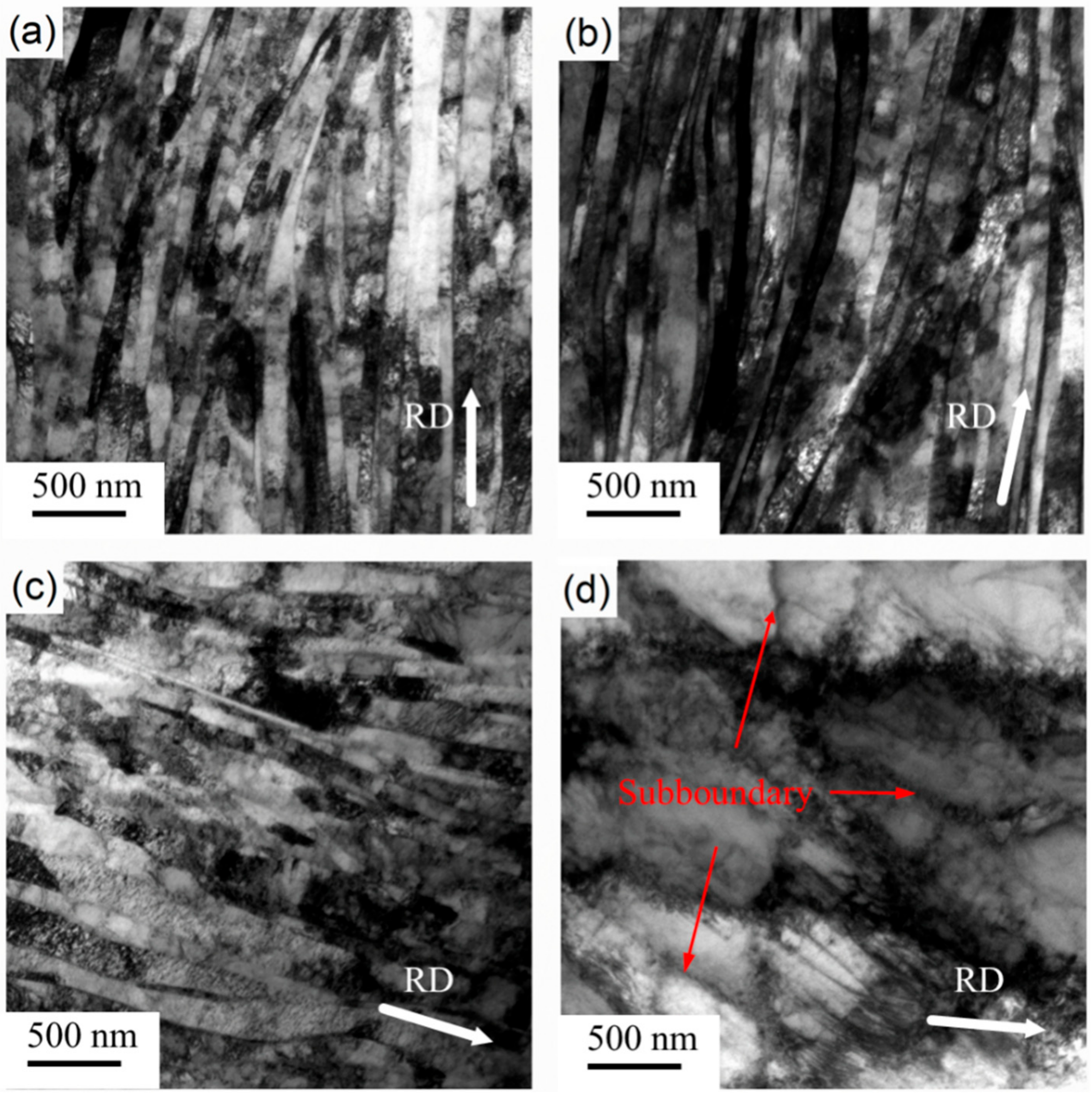
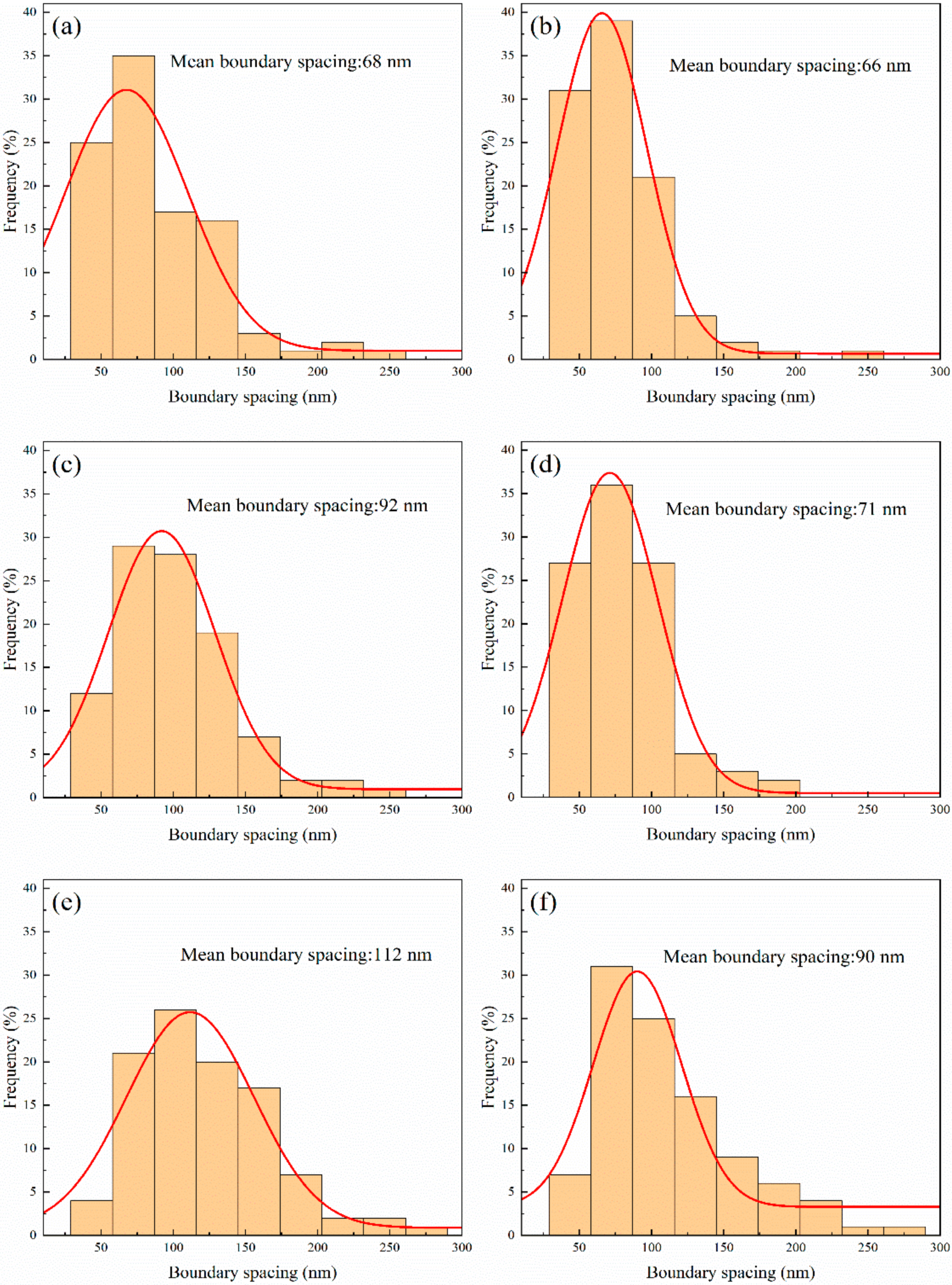
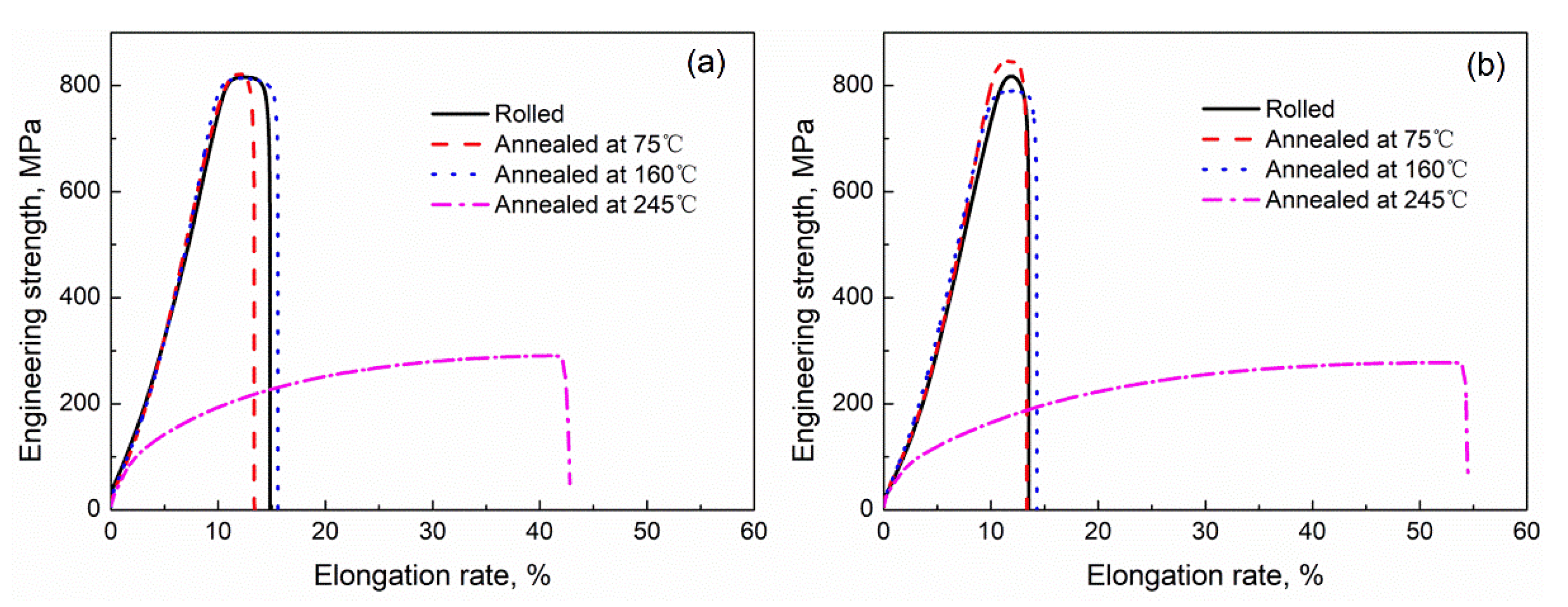
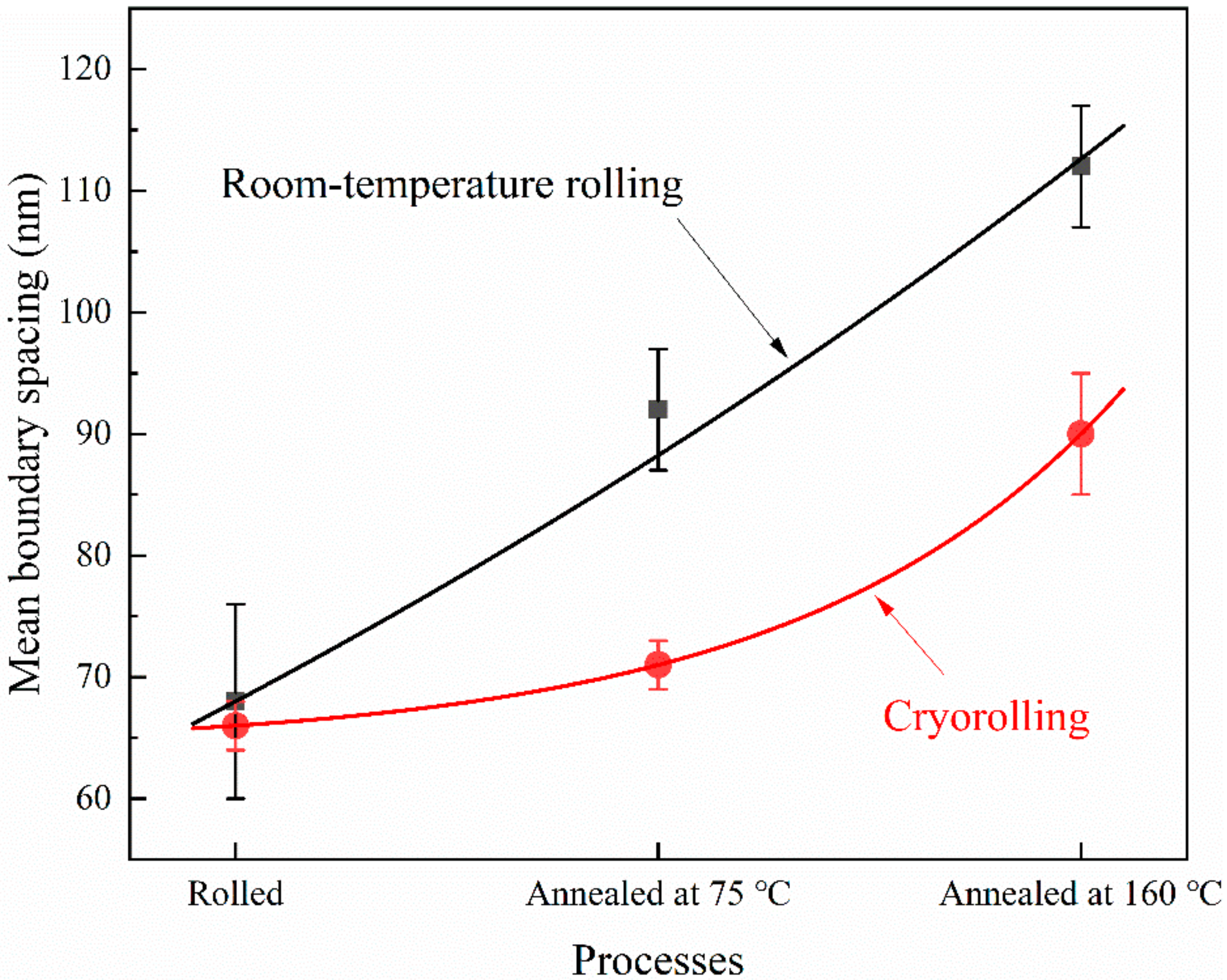
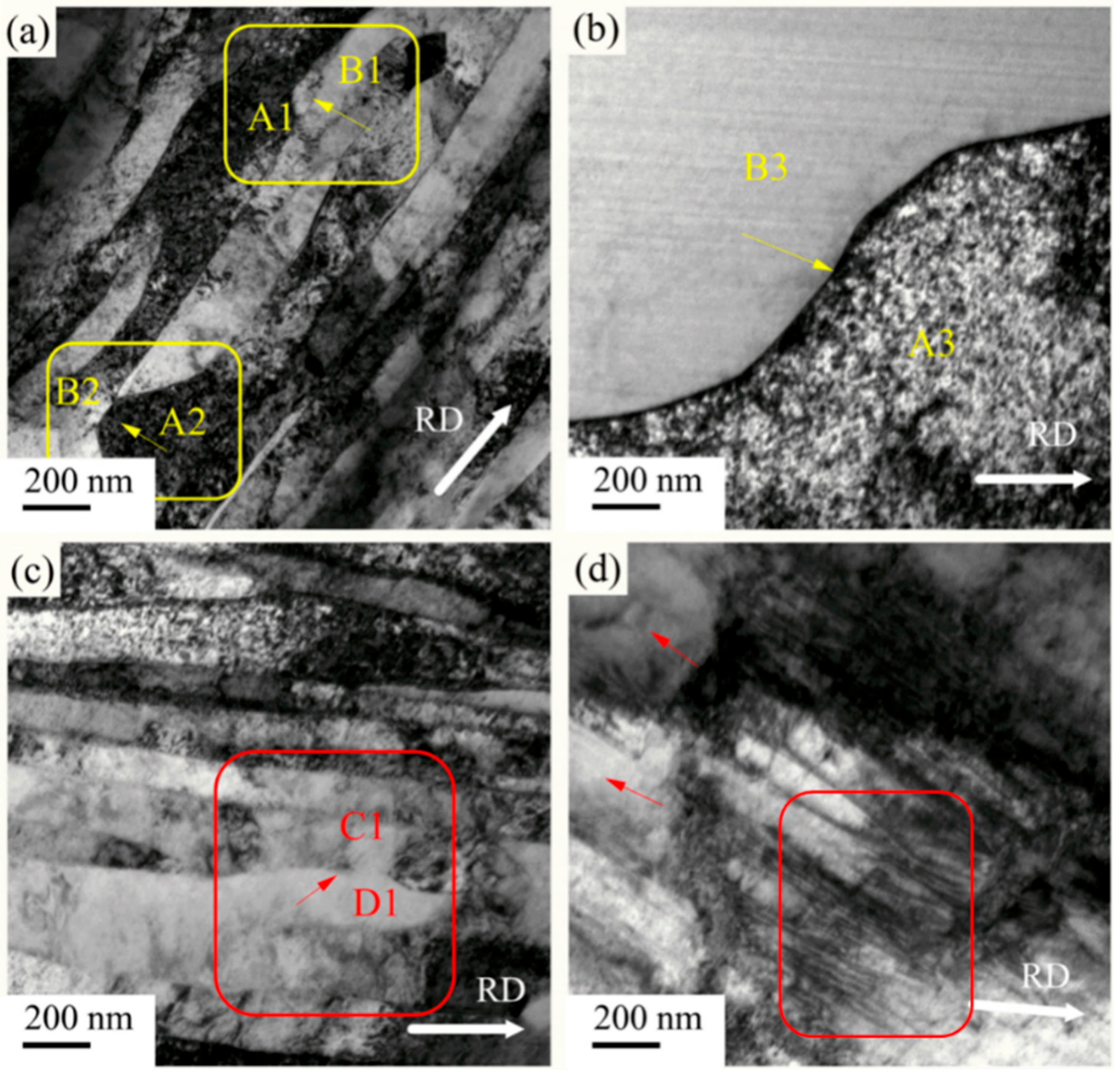
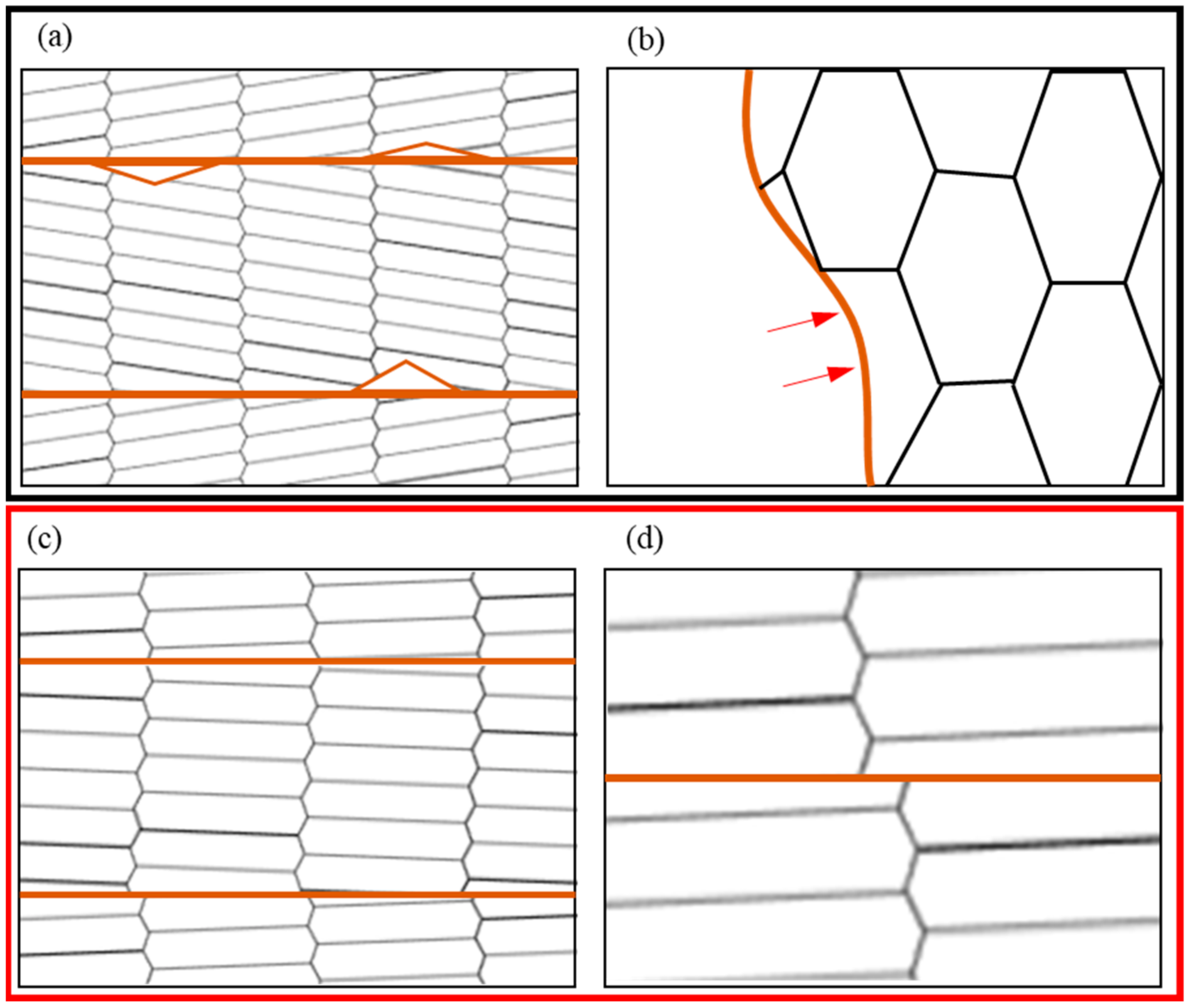
| Processes | Annealed Temperature | Tensile Strength (MPa) | Elongation Rate (%) |
|---|---|---|---|
| Room-temperature rolled | As rolled | 811 ± 3 | 14 ± 1 |
| Annealed at 75 °C | 821 ± 6 | 14 ± 1 | |
| Annealed at 160 °C | 768 ± 11 | 14 ± 1 | |
| Annealed at 245 °C | 279 ± 10 | 48 ± 6 | |
| Cryorolled | As rolled | 820 ± 2 | 14 ± 1 |
| Annealed at 75 °C | 830 ± 10 | 14 ± 1 | |
| Annealed at 160 °C | 779 ± 8 | 14 ± 1 | |
| Annealed at 245 °C | 278 ± 9 | 54 ± 4 |
Publisher’s Note: MDPI stays neutral with regard to jurisdictional claims in published maps and institutional affiliations. |
© 2021 by the authors. Licensee MDPI, Basel, Switzerland. This article is an open access article distributed under the terms and conditions of the Creative Commons Attribution (CC BY) license (https://creativecommons.org/licenses/by/4.0/).
Share and Cite
Li, Z.; Wu, Y.; Xie, Z.; Kong, C.; Yu, H. Grain Growth Mechanism of Lamellar-Structure High-Purity Nickel via Cold Rolling and Cryorolling during Annealing. Materials 2021, 14, 4025. https://doi.org/10.3390/ma14144025
Li Z, Wu Y, Xie Z, Kong C, Yu H. Grain Growth Mechanism of Lamellar-Structure High-Purity Nickel via Cold Rolling and Cryorolling during Annealing. Materials. 2021; 14(14):4025. https://doi.org/10.3390/ma14144025
Chicago/Turabian StyleLi, Zhide, Yuze Wu, Zhibao Xie, Charlie Kong, and Hailiang Yu. 2021. "Grain Growth Mechanism of Lamellar-Structure High-Purity Nickel via Cold Rolling and Cryorolling during Annealing" Materials 14, no. 14: 4025. https://doi.org/10.3390/ma14144025
APA StyleLi, Z., Wu, Y., Xie, Z., Kong, C., & Yu, H. (2021). Grain Growth Mechanism of Lamellar-Structure High-Purity Nickel via Cold Rolling and Cryorolling during Annealing. Materials, 14(14), 4025. https://doi.org/10.3390/ma14144025







